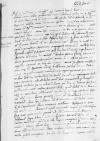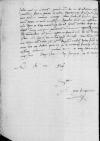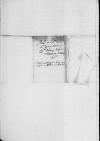Quamprimum ⌊Viennam⌋ appuli, litteras Dominationis Vestrae Magnificae ad ⌊dominum Cracoviensem⌋ perferendas curavi. Factum est postea, ut dominus ⌊Sigismundus de Herberstain⌋ una cum ⌊praeposito ⌊Albae Regalis⌋⌋ orator in ⌊Poloniam⌋ a ⌊serenissimo rege nostro⌋ missus fuerit. Ibi poterit ipsemet, tamquam a me informatus, latius cum ⌊reverendissimo Cracoviensi⌋ tam circa Dominationis Vestrae statum quam circa Barense negotium dis<s>erere. Nova autem Hungarica, si Dominatio Vestra Magnifica quaerit, sunt, quod post illam victoriam ⌊regis nostri⌋ apud ⌊Tokay⌋, ubi ⌊waiwodae⌋ exercitus non sine factura sua diffusus dispalatusque fuit, accidit ut, vel incuria nostrorum, vel loci facilitate, ⌊Wodi Ferenz⌋, unicus iam apud waiwodam capitaneus, congregatis circiter duobus milibus hominum ⌊Agriense Castrum⌋ expugnaverit, post multas tamen nostrorum repulsiones, saepius enim id frustra tentaverat. Tandem potitus foedeque abusus victoria, Germanos quosdam pedites partim palis affixit, partim aliis suppliciis necavit. Ne itaque hoc venenum latius irreperet, mis{s}it contra eum ⌊rex noster⌋ sescentos circiter husserones sub capitaneo Corvato ⌊Pickri Laus⌋ ac quadringentos cathafractos equites Germanos, qui in itinere fere omnes in valetudinem inciderunt, ita ut vix septuaginta bellum sequi potuerint, ubi ad hostes ventum fuit. Pugnaverunt per integram diem incerta victoria, ita ut nuntiatum fuerit per aliquos tirones, qui initio ex proelio aufugerant, nostros penitus fusos, quod modo falsum fuit, pro munere enim novi anni adduxerunt nostri huc et ⌊serenissimo regi⌋ obtulerunt captivum illum ⌊Wodi Ferenz⌋, gentesque suas tum trucidarunt, tum in fugam verterunt. Fuit haec victoria non tam ob multitudinem hostium caesam, quam ob captivitatem istius maxime necessaria: reliquus enim erat hic solus ⌊dux strenuus⌋ apud ⌊waiwodam⌋, in quo omnis illius spes fixa erat, quia multae gentes ad illum concurrebant. Nunc penitus desolatus degit ultra ⌊Tybiscum⌋, quamvis enim vervecem adhuc secum habeat, parum refert, cum sit homo ille lingua promptior quam manu. Brevi audietur ulterior ipsius fuga, timendum enim iam sibi est a suismet, ne, dum illum in huiusmodi statu vident, studeant eius morte regis nostri gratiam aucupari. Et haec de ⌊Hungaris⌋.
Cetera vero de
⌊Italia⌋ apud vos latius, gratulor autem Dominationi Vestrae de adventu ⌊supremi cancellarii⌋, fieri enim poterit, ut eadem legationi suae finem possit imponere praesertim mortuo ⌊vicerege⌋. Nunc scribo ad ⌊eundem cancellarium⌋ petens, ut mihi in assequendo stipendio ⌊patris mei⌋ assistere velit. Nam et ⌊rex meus⌋ super hoc ad ⌊caesarem⌋ scribit. Rogo, Dominatio Vestra dignetur tamquam antiquus patronus eum convenire negotiumque meum illi commendare, vel potius cogere, ut favorem suum rei tam honestae praestare velit, scio enim Dominationem Vestram omnia apud illum posse. ⌊Marchioni illustrissim[o]⌋ me commendatum velim, cui ⌊serenissimus rex noster⌋ multum debet fratris ⌊Casimiri⌋ loco, nec dubium, quin et ipsi et universae familiae illi clarissimae relaturus. Valeat Dominatio Vestra Magnifica meque habeat, ut solet, inter suos.


